
Qualify for the
179D Tax Deduction

179D Tax Deduction New Mexico
The 179D Energy Efficient Building Deduction (EPAct) is a tax deduction of up to $5.00/sf that is available to those in New Mexico investing in energy-efficient improvements placed in service after December 31, 2005. Ideal candidates for 179D deductions are architects, engineers, and design-build contractors of tax-exempt buildings as well as commercial building owners.
Our team of engineers and tax experts will obtain the maximum EPAct 179D Tax Deduction available in the state of New Mexico, following IRS guidance. The tax deduction applies to energy-efficient lighting, HVAC systems, and the building envelope. The process for obtaining the 179D deduction in New Mexico requires a detailed analysis that must be certified by a qualified third party. KBKG has the in-house expertise and the necessary professional qualifications to certify your New Mexico property as required by the IRS.
Case Study: New Mexico
A fire station in Santa Fe, New Mexico with 41,554 square feet qualified for the 179D full tax deduction.
KBKG successfully obtained $74,797 in total 179D tax deductions.
What is the EPAct 179D Tax Deduction?
The 179D Deduction, also known as the Energy-Efficient Commercial Buildings 179D Tax Deduction, is a tax incentive first introduced in 2005 as part of the Energy Policy Act. The program’s intent is to drive commercial building owners and Designers of tax-exempt buildings to reduce their energy use by rewarding the implementation of energy efficient building components, specifically, the HVAC system, interior building lighting, and the building envelope for newly constructed buildings or renovations. In 2020, 179D became a permanent part of the tax code.
Who can Qualify?
- Architects, Mechanical Engineers, Electrical Engineers, and other designers of tax-exempt buildings
- Commercial Building Owners
Commercial building owners who are taxpayers can benefit from the program in the form of accelerated depreciation. However, many of the largest commercial buildings in the United States are owned by non-tax-paying entities, such as local municipalities, State and Federal governments, military facilities, K-12 schools, universities, etc., and therefore, they can’t reap the financial benefits of a tax deduction. However, Congress still wanted to incentivize the inclusion of energy-efficient components in these buildings, so they expanded 179D to allow the building owner (government entity) the ability to allocate their deduction to the taxpaying designer of the energy-efficient properties of the buildings.
What did the Inflation Reduction Act Change?
In 2022 and prior years, architects, engineers, and design-build contractors are eligible to receive allocations on projects they designed for federal, state, and local government-owned buildings. Starting in 2023, they can ALSO receive allocations for their design work on the tax-exempt entities listed below. This means many building types that were previously ineligible to participate in 179D can now do so!
Further, the Inflation Reduction Act significantly expanded the benefit of the program from up to $5.00/square foot.
Eligibility Expansion in 2023 and forward includes Tax-Exempt Entities
In 2022 and prior years Architects, Engineers, and Design-Build contractors are eligible to receive allocations on projects they designed for federal, state, and local government-owned buildings. Starting in 2023 they can now ALSO receive allocations for their design work on the tax-exempt entities listed below. This means many building types that were previously ineligible to participate in 179D now can!
Eligible Tax-Exempt Entities
Charitable Organization
Churches & Organizations
Private Schools & Universities
Private Foundations
Political Organizations
Other Non-Profits
Native American Tribal Governments
Alaska Native Corporations
Frequently Asked Questions
Taxpayers in New Mexico that invest in ground-up construction or in improvements to their existing buildings are potentially eligible for 179D deductions. Eligible improvements must reduce energy use by investing in any of the following categories: a building's envelope, HVAC, and/or interior lighting systems. There are different ways to pursue a deduction and all require certification by a qualified expert.
Architects and designers in New Mexico who implement energy-efficient designs on government buildings are also eligible for the 179D deduction if their design meets the criteria.
Unlike most deductions, which are based on the amount spent, this deduction is primarily based on affected square footage. Ideal candidates will generally have improvements with a square footage of at least 50,000 square feet. A wide range of improvements, from simple lighting retrofits to full-scale construction projects, qualify for this timely tax break. Other great candidates include regional or national chains with multiple locations.
The basis for developing and supporting this deduction is a detailed engineering analysis, as prescribed by the IRS. Our multi-disciplinary team of engineers and tax experts will ensure that you obtain the maximum available deductions while following IRS guidance to properly certify the tax deductions. Additionally, our team can help you claim deductions that were missed from prior years.
Get a Free Download of this 179D One Pager
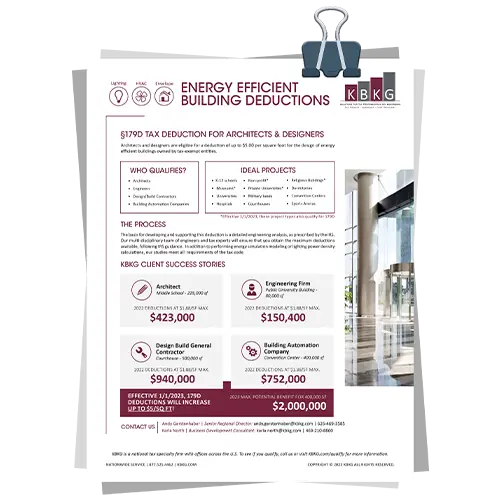
What are the Benefits of the 179D Tax Deduction?
|
Size of Improvement
|
Partial Tax Deductions Available Prior to 2023
|
Maximum Tax Deduction 2022
|
Maximum Tax Deduction 2023
|
||
|
Lighting
|
HVAC
|
Envelope
|
|||
|
50,000 sf
|
$15.75K - $31.5K
|
$31.5K
|
$31.5K
|
$94K
|
$250K
|
|
100,000 sf
|
$31.5K - $63K
|
$63K
|
$63K
|
$188K
|
$500K
|
|
300,000 sf
|
$94.5K - $189K
|
$189K
|
$189K
|
$564K
|
$1,500K
|
What Improvements are Eligible for the 179D Deduction?
Taxpayers in New Mexico that invest in ground-up construction or in improvements to their existing buildings are potentially eligible for 179D deductions. Eligible improvements must reduce energy use by making investments in any of the following categories: a building’s envelope, HVAC, and/or interior lighting systems. There are different ways to pursue a deduction and all require comparison to the ASHRAE Standards and certification by a qualified individual.
Building Envelope
Energy efficient construction or improvements to walls, floors, roofs, fenestrations, and doors
HVAC
Improvements relating to energy efficient HVAC systems
Lights
Construction or improvements to building lights for energy efficiency
179D Tax Insights

Trump’s Pledge to Repeal Green Energy Incentives Faces GOP Resistance
03/18/2025By Jonathan Tucker | Principal, Research & Development Tax Credits There are developments within the Republican Party, as 21 House Republicans have urged President Trump and House Speaker Mike Johnson (R-Louisiana) not to repeal specific green tax incentives established under the Inflation Reduction Act (IRA) of 2022, enacted during President Biden’s administration. These lawmakers emphasize … Read More

Consider 179D Now Incase Tax Reform Reduces the Benefit
03/07/2025By Jesse Stanley | Principal, Green Building Tax Incentives As policymakers continue to discuss tax priorities, 179D candidates—particularly architects, engineers, and other designers—face growing uncertainty around the future of this powerful deduction. With potential legislation threatening to scale back benefits, design professionals who rely on 179D to demonstrate value and reduce taxable income should consider acting … Read More
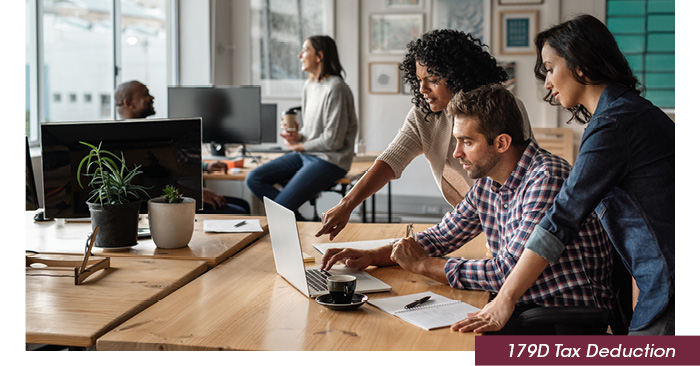
Leveraging 179D to Strengthen Relationships in the Design Community
03/06/2025By Jillian Jones | Director, Green Building Tax Incentives The 179D Tax Deduction is a powerful tax incentive for architects, engineers, and designers working to improve energy-efficiency in government, nonprofit, and other tax-exempt buildings. However, when it comes to allocating the deduction to the designers, tax-exempt entities have historically done so on a first-come, first-served basis, creating … Read More
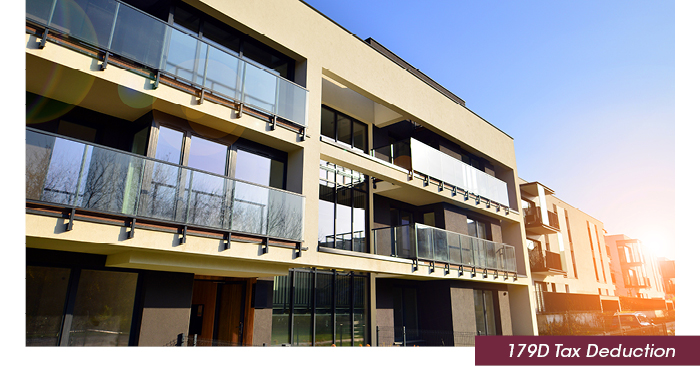
KBKG Joins Organization to Advocate for Architects
09/26/2024KBKG Principal Jesse Stanley has joined the Real Estate Roundtable’s Sustainability Committee. Stanley joins other KBKG principals involved in the organization, adding to KBKG’s influence in developing legislation for a more sustainable future. The Real Estate Roundtable is an association that represents the commercial real estate industry and established the Sustainability Committee to address the … Read More
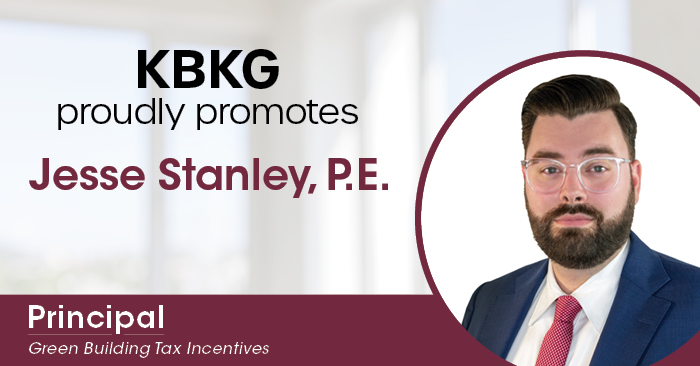
KBKG Proudly Promotes Jesse Stanley to Principal of Green Building Tax Incentives
09/25/2024PASADENA, Calif. – September 25, 2024 – KBKG, a nationwide leader in specialized tax services and solutions, proudly announces the promotion of Jesse Stanley to Principal, joining its executive team. In his elevated role, Stanley will oversee and lead all of KBKG’s Green Building Tax Incentives (GBTI) services, including the 179D Tax Deduction and the … Read More
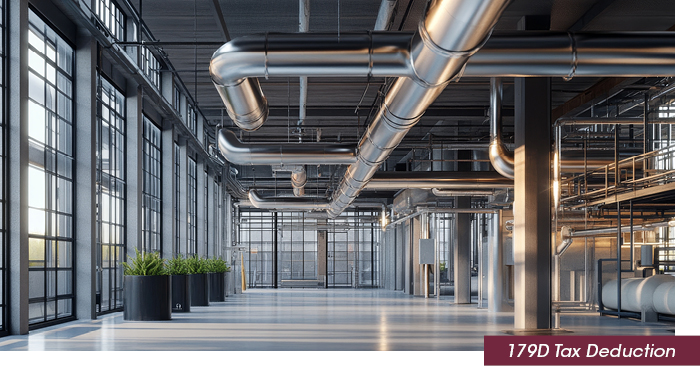
ASHRAE Standards for Energy-Efficient Buildings
08/28/2024The 179D Tax Deduction offers significant financial rewards for designers who reach specific energy-efficiency benchmarks defined by the American Society of Heating, Refrigerating, and Air-Conditioning Engineers (ASHRAE) on their designs of government-owned or tax-exempt buildings. ASHRAE 90.1 determines the energy-efficiency criteria that designers need to meet to reap the benefits of 179D. Currently, the required … Read More
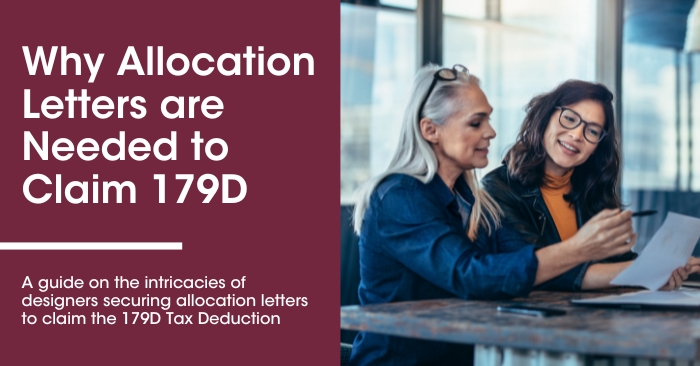
Why Allocation Letters are Needed to Claim 179D
11/07/2023Why Allocation Letters are Needed to Claim 179D A guide on the intricacies of designers securing an allocation letter to claim 179D Thought Leadership from Jillian Jones, Senior Manager – Green Building Tax Incentives Architects and designers play a crucial role in creating energy-efficient, tax-exempt buildings, and many need to be made aware of how … Read More
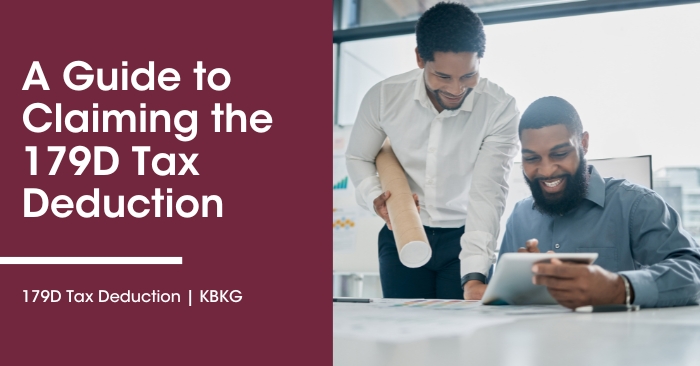
A Guide to Claiming the 179D Deduction
10/31/2023Using the 179D Deduction Successfully running and managing a business requires paying attention to a lot of things, including tax planning. Taxes get complicated, and it can be tough for the average business owner to know which deductions and credits could benefit their company. Take the 179D deduction. This provision allows eligible taxpayers to get … Read More
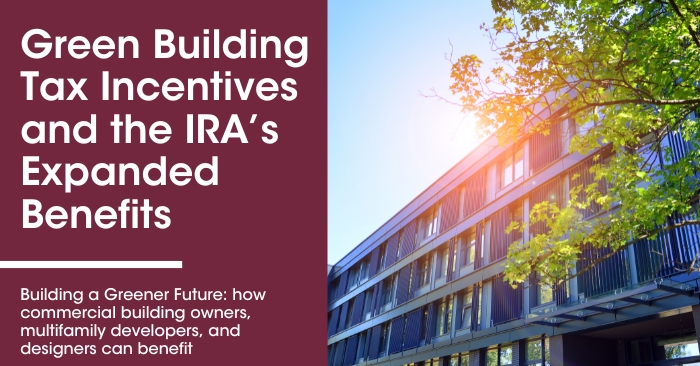
Green Building Tax Incentives and The IRA’s Expanded Benefits
09/30/2023Green Building Tax Incentives and the IRA’s Expanded Benefits Building a Greener Future: how commercial building owners, multifamily developers, and designers can benefit With a goal of substantially reducing greenhouse gas emissions by 2030, the federal government has expanded a series of Green Building Tax Incentives. These initiatives represent a crucial step in the larger effort to … Read More
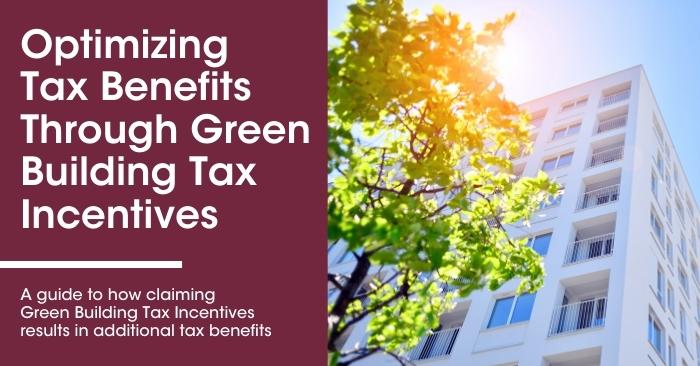
Optimizing Tax Benefits Through Green Building Tax Incentives
09/29/2023Optimizing Tax Benefits Through Green Building Tax Incentives A guide on how claiming Green Building Tax Incentives results in additional tax benefits With more building owners and designers constructing commercial and residential buildings that meet the energy-efficiency standards to qualify a project for Green Building Tax Incentives, candidates should also know what other opportunities for … Read More


